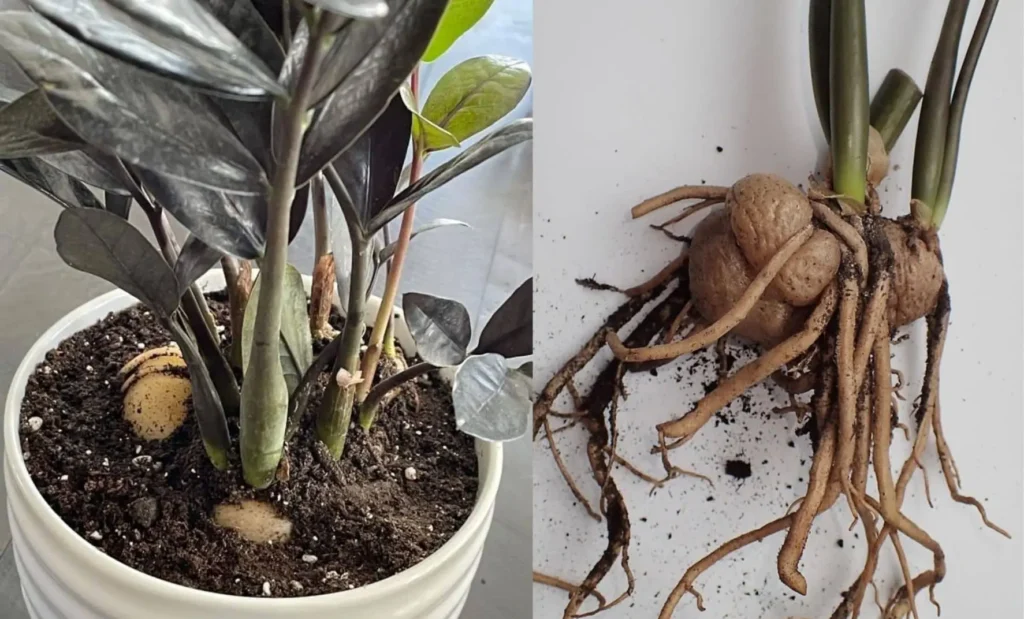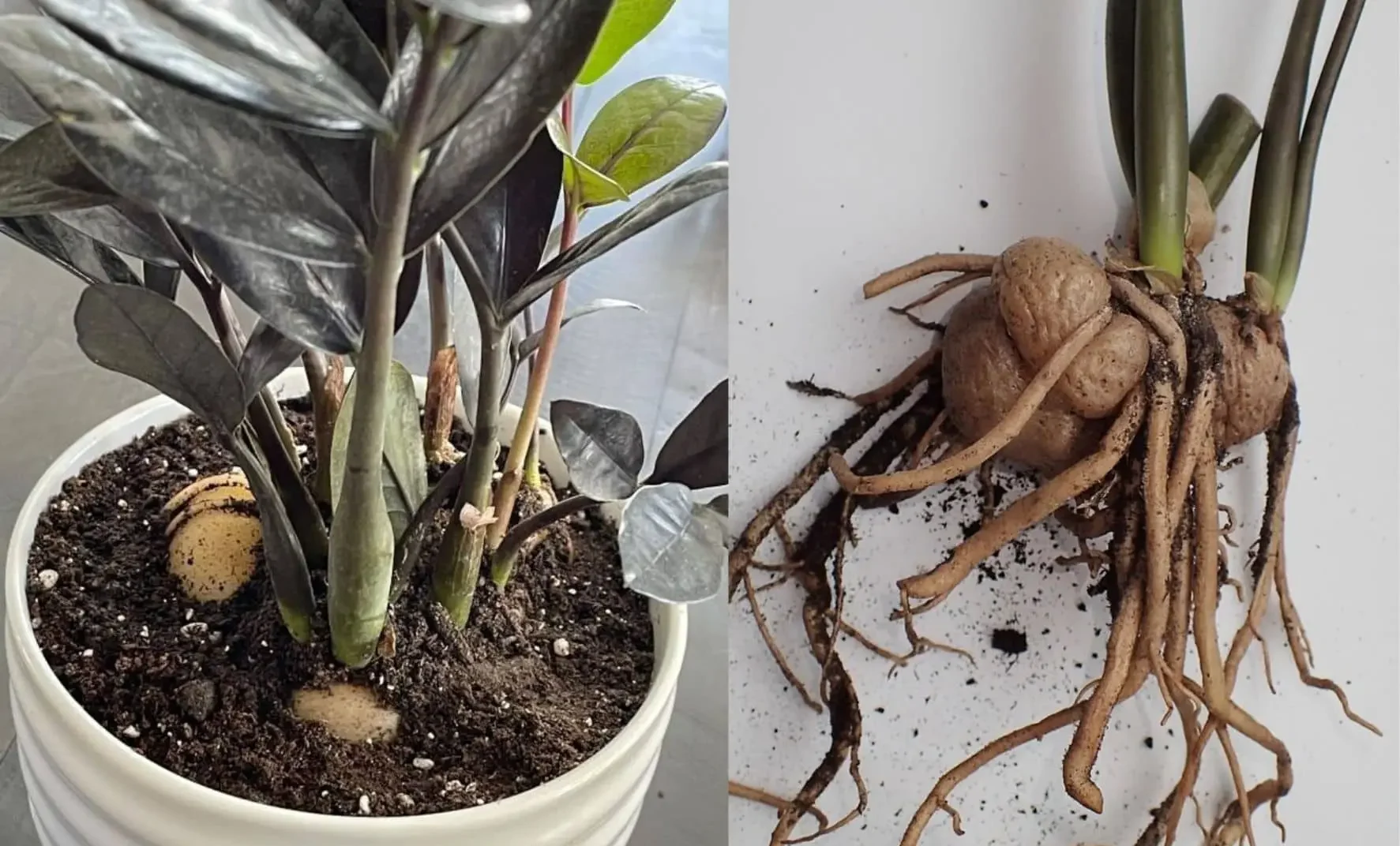The ZZ plant, also known as the Zamioculcas zamiifolia, is a popular houseplant known for its shiny, dark green leaves and its ability to thrive in low-light conditions.
One of the unique features of the ZZ plant is its rhizomes, which are thick underground stems that store energy and nutrients for the plant.
In this blog post, we will explore what Zamioculcas zamiifolia rhizomes are, their importance for the plant, what can happen if they are exposed, how to plant them, and if this plant can grow from a rhizome.

What is a ZZ Plant Rhizome?
A rhizome is a thick underground stem that stores energy and nutrients for the plant. It is typically found just below the surface of the soil and is responsible for producing new growth and spreading the plant.
In the case of the ZZ plant, the rhizomes are fleshy and can be easily propagated to create new plants.
The rhizome of a Zamioculcas zamiifolia is typically a brown color and can be up to 2 inches in diameter.
They are typically found just below the surface of the soil and can be easily identified by their fleshy texture and characteristic shape.
Importance of Rhizomes for ZZ Plants
Rhizomes play an important role in the growth and survival of the ZZ plant. They store energy and nutrients for the plant, which helps it to survive during periods of stress, such as drought or low light conditions.
Rhizomes also allow the plant to spread and create new growth, which is how the plant reproduces.
In addition, a ZZ plant’s rhizomes also help anchor the plant in place, preventing it from being easily knocked over or blown away.
What can happen if ZZ Rhizomes are exposed?
If the rhizomes of a ZZ plant are exposed, they can dry out and die. This can happen if the soil is too shallow or if the rhizomes are not covered with enough soil when planting.
In addition, if the rhizomes are exposed to direct sunlight, they can become sunburned and die.
It is also important to note that if the rhizomes are exposed to too much moisture, they can rot and cause the plant to die.
Can You Cut a ZZ Plant Rhizome?
Yes, you can cut a ZZ plant rhizome. When cutting this plant rhizome, it is important to make sure that each piece has at least one healthy leaf and one growing point.
After cutting, the pieces should be allowed to dry for a few days before planting to allow the cut surfaces to callus over and prevent rot.
How to Plant ZZ Rhizomes
When planting ZZ rhizomes, it’s important to follow these steps:
- Choose a container with drainage holes and fill it with a well-draining soil mix. A good option is to use a mixture of equal parts peat moss, perlite, and sand.
- Carefully remove the rhizome from its current container, being careful not to damage the roots.
- Place the rhizome in the new container and cover it with soil, making sure that the top of the rhizome is just barely exposed.
- Water the soil well to moisten it and keep the soil consistently moist but not waterlogged.
- Place the container in a location that receives bright, indirect light.
- Keep an eye on the soil moisture and water the plant when the top inch of the soil is dry.
- After a few weeks, new growth should appear, and the plant will begin to establish itself in its new container.
It’s important to note that when planting a ZZ plant, it is essential to use a well-draining soil mix, as the rhizomes can rot if they are sitting in water.
Also, it is important to place the plant in a location that receives bright, indirect light, and to keep the soil consistently moist but not waterlogged.
Can a ZZ Plant Grow from a Rhizome or Bulb?
Yes, a ZZ plant can grow from a rhizome. In fact, propagating a ZZ plant from a rhizome is a relatively easy process.
Simply cut a healthy rhizome from an existing plant and plant it in well-draining soil.
Keep the soil consistently moist and place the plant in a location that receives bright, indirect light.
To propagate a Zamioculcas zamiifolia from a rhizome, you will need a sharp knife or pruning shears. Carefully cut a healthy rhizome from an existing plant, making sure to include at least one set of leaves.
Allow the cut end of the rhizome to dry for a few days before planting it in well-draining soil.
Keep the soil consistently moist, but not waterlogged, and place the plant in a location that receives bright, indirect light.
It is important to note that it can take several weeks to several months for a new plant to grow from a rhizome, depending on the size of the rhizome and the conditions it is grown in.
Be patient, and don’t be discouraged if it takes a while for new growth to appear.
FAQs:
What are ZZ plant rhizomes?
ZZ plant rhizomes are thick underground stems that store energy and nutrients for the plant. They are responsible for producing new growth and spreading the plant.
Why are rhizomes important for ZZ plants?
Rhizomes play a crucial role in the growth, survival, and reproduction of ZZ plants. They store energy and nutrients, aid in spreading the plant, and help anchor it in place.
What can happen if ZZ plant rhizomes are exposed?
Exposed rhizomes can dry out, become sunburned, or rot, leading to plant stress or death. It’s crucial to ensure they are adequately covered with soil to maintain their health.
Can you cut ZZ plant rhizomes?
Yes, you can cut ZZ plant rhizomes for propagation. Ensure each piece has at least one healthy leaf and growing point. Allow cut surfaces to dry before planting to prevent rot.
How do you plant ZZ rhizomes?
Plant ZZ rhizomes in well-draining soil, ensuring the top of the rhizome is just exposed. Keep the soil moist but not waterlogged and place the plant in bright, indirect light.
Can a ZZ plant grow from a rhizome or bulb?
Yes, ZZ plants can grow from rhizomes. Propagate by cutting a healthy rhizome with at least one set of leaves, allowing it to dry before planting in well-draining soil.
How long does it take for a ZZ plant to grow from a rhizome?
It can take several weeks to several months for new growth to appear from a ZZ plant rhizome, depending on its size and growing conditions. Be patient during the propagation process.
How do you identify ZZ plant rhizomes?
ZZ plant rhizomes are typically brown, fleshy, and can be up to 2 inches in diameter. They are found just below the soil surface and have a distinctive texture and shape.
Can ZZ plant rhizomes be divided?
Yes, ZZ plant rhizomes can be divided to create new plants. Ensure each division has sufficient roots and healthy foliage for successful propagation.
What are the signs of rhizome damage in ZZ plants?
Signs of rhizome damage include wilting, yellowing, or browning of leaves, stunted growth, or the presence of rot. Prompt action is necessary to address damage and prevent further issues.
How often should ZZ plant rhizomes be watered?
Water ZZ plant rhizomes when the top inch of soil is dry. Avoid overwatering to prevent rot, but ensure the soil remains consistently moist to support healthy growth.
Can ZZ plants survive if their rhizomes are damaged?
ZZ plants can recover from rhizome damage if the majority of the rhizome remains intact. Providing proper care, such as adjusting watering and light conditions, can aid in recovery.
Are ZZ plant rhizomes toxic to pets?
ZZ plant rhizomes contain calcium oxalate crystals, which can be toxic if ingested by pets. Keep rhizomes out of reach of animals and seek veterinary assistance if ingestion occurs.
Do ZZ plant rhizomes require fertilizer?
ZZ plant rhizomes do not require frequent fertilization. Use a balanced fertilizer diluted to half-strength during the growing season to support healthy growth, but avoid overfertilization.
Can ZZ plant rhizomes be kept above soil level?
While ZZ plant rhizomes prefer to be just below the soil surface, they can survive if partially exposed. However, keeping them covered with soil helps maintain moisture and prevents damage.
Can ZZ plant rhizomes be propagated in water?
ZZ plant rhizomes can be propagated in water, although it may take longer for roots to develop compared to planting in soil. Change the water regularly to prevent stagnation and monitor for root growth.
Do ZZ plant rhizomes produce flowers?
ZZ plant rhizomes can produce small, yellowish-green flowers under optimal growing conditions, although it is relatively rare for indoor ZZ plants to bloom.
How do you troubleshoot issues with ZZ plant rhizomes?
If ZZ plant rhizomes are showing signs of stress or damage, assess environmental factors such as light, water, and temperature. Adjust care practices accordingly and monitor for improvements.
Can ZZ plant rhizomes be stored for future use?
ZZ plant rhizomes can be stored for short periods if necessary. Keep them in a cool, dry place and ensure they are not exposed to direct sunlight or excessive moisture.
Are ZZ plant rhizomes invasive?
ZZ plant rhizomes can spread and produce new growth, but they are not typically considered invasive. However, they may need occasional containment if they outgrow their designated space.
How do you revive wilted ZZ plant rhizomes?
If ZZ plant rhizomes are wilted due to underwatering or environmental stress, thoroughly water the plant and ensure it receives adequate light. Trim any damaged foliage and monitor for recovery.
Can ZZ plant rhizomes be repotted?
ZZ plant rhizomes can be repotted if the plant outgrows its current container or if the soil becomes compacted. Repot during the spring or early summer using fresh, well-draining soil.
Do ZZ plant rhizomes require pruning?
ZZ plant rhizomes do not require pruning in the same way as above-ground foliage. However, remove any damaged or rotting rhizome sections to maintain plant health.
How do you prevent pests and diseases in ZZ plant rhizomes?
Maintain proper growing conditions, avoid overwatering, and inspect the plant regularly for signs of pests or diseases. Treat any issues promptly using appropriate methods or products.
Can ZZ plant rhizomes be divided without damaging the parent plant?
ZZ plant rhizomes can be divided carefully to minimize damage to the parent plant. Ensure each division has sufficient roots and foliage to support growth independently.
Conclusion
The ZZ plant is a unique and hardy houseplant that is known for its shiny, dark green leaves and its ability to thrive in low-light conditions.
One of the key features of the ZZ plant is its rhizomes, which are thick underground stems that store energy and nutrients for the plant.
Understanding the importance of rhizomes and how to properly care for them is key to keeping a healthy and thriving Zee Zee plant.
With proper care, a Zamioculcas zamiifolia can be a beautiful and low-maintenance addition to any home.

